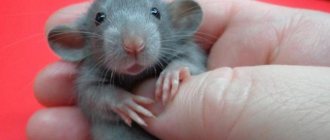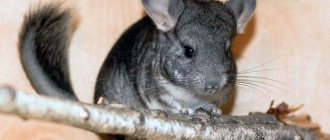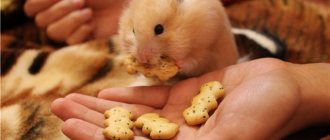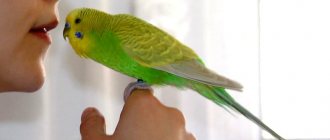Such cute creatures stand out from other rodents. Cute animals are very friendly and non-confrontational. They will not scratch or bite if handled carefully. Chinchillas raised from childhood will be completely tamed and devoted to their owner. These amazing animals have many advantages:
- Quite attractive appearance;
- calm and not aggressive;
- The animal has no smell because it has no sweat glands. His feces and urine do not stink;
- Easy to tame. A gentle, trusting attitude, and the animal becomes tamed;
- Animal fur does not cause allergies;
- Rodents rarely get sick;
- They can easily be left home alone for the weekend. With enough food and water, they can easily live without their owners.
Chinchillas will live twenty years or more if proper care is followed. Here are some of them that are worth paying attention to:
- The optimal room temperature is 18 degrees Celsius. At temperatures of 28 degrees or higher, the animal may suffer from heatstroke and die. At temperatures below 10 degrees it may freeze due to hypothermia.
- You should treat your pet to a dust bath several times a week. To do this, you need to buy a special bath and volcanic dust. To prevent skin diseases, healing sulfur is added to it. This procedure cleanses the coat well and relieves stress. Washing an animal in water is strictly prohibited, as it can freeze and die.
- Feed once a day special food for chinchillas. Food intended for other rodents is absolutely not suitable; they have a different composition. It is allowed to give treats: rose hips, apricots, apples, pears, raisins, plums, but only in dried form.
Adaptation of a chinchilla after purchase
When moving to a new place, into a new cage and changing owners, the animal experiences some stress. At first it is very difficult to accustom an adult chinchilla to your hands. There are a number of recommendations that must be followed to make the chinchilla more easily adapt to new living conditions:
- A rodent will adapt to new owners faster if purchased at a young age. Adults will need more time to get used to it.
- For quick acclimatization, ask what food the animal was fed, since a sudden change in diet does not contribute to quick adaptation.
- In order not to scare the animal in the first days, approach the cage without sudden movements and slowly. It is important not to make noise or express emotions loudly.
- Talk calmly to your pet. Increase the time you spend near the cage. In this way, the chinchilla will gradually get used to its owner.
- Take your time holding your chinchilla, but gradually train him by hand-feeding him treats. This is done with the cage door open, when the animal stops hiding when the owner approaches.
The rodent will not accept the treat immediately. First you need to get used to new smells. Wash your hands well before applying treats to your hand and do not apply cream to your hands. For the first time, the animal can take the treat and eat it in a secluded place.
However, if the owner is patient, then within a week the chinchilla will begin to feed directly from his hands. This daily routine should be repeated in the evening when the chinchilla is active.
Take your time with your chinchilla and try to pick him up after feeding. This may frighten him and cause an aggressive reaction. Wait until his natural curiosity encourages further interaction.
In order not to disturb the animal, the owner must warn it of its approach with some kind of sound. Then, from the very beginning of communication, the animal will be calm. Over time, the pet will greet its owner with joy.
Additional recommendations
Additional recommendations on how to train a chinchilla will help owners quickly find contact with the animal and make the training process enjoyable and carefree:
- It is better not to feed the animal through the bars of the cage; it is better to always try to do it by hand, or through the open door of the cage;
- You can check how friendly your pet is by holding your hand to its nose. If the chinchilla begins to lick it and smell it, you can continue training. And if she starts to snort, run away or bite, then it’s better to just talk to her and leave her alone, we’ll try again a little later;
- Every time a chinchilla climbs into your arms, you must reward it with some kind of treat: this way, it will know that such an action is completely safe for it.
It is very easy to accustom a chinchilla to your hands if you act in stages, step by step. Despite their initial mistrust, these are very loyal, affectionate and sweet pets!
How to make friends with a chinchilla
If you buy a young chinchilla, it is much easier to tame and bond with it than with an adult. The life history of a mature chinchilla can be very negative. In this case, it is not easy to restore trust in people. Only if the owner has enough patience can positive results be expected. This may take months. Therefore, you should carefully consider the capabilities and age of rodents.
To make friends with your pet, you first need to get rid of his fears. If you watch him closely, you may notice signs of fear. It looks like this:
- Any human movement causes alertness and stress in the animal;
- when approached, he quickly wakes up and takes a defensive position;
- there is a nervous tremor in the body;
- He snores and barks, trying to get into the stream of urine;
- tends to bite an outstretched hand;
- sheds pieces of hair.
Building trust is a slow process. Therefore there is no need to speed it up. The chinchilla is quite smart and remembers both positive and negative situations well. Only love and thoughtful actions will lead to the beginning of a trusting and happy relationship.
What not to do
An animal cannot be trained by force. If the animal is not in the mood and reacts negatively to human actions, then it is better to leave it alone. Under no circumstances should you yell at your pet. He is very timid and cannot stand being forced. You should not pick up a chinchilla by the tail, otherwise it can be injured. Only with care and patience can you achieve the desired result and good relationships.
The chinchilla is great as a pet. Thanks to her intelligence, she is well trained. You can establish communication with a rodent without any problems. Keeping these beautiful animals is not that difficult. A trusting relationship will allow you to enjoy each other's company for many years.
How not to behave with a chinchilla?
To make the domestication process comfortable, it is best to avoid certain activities that may negatively affect your interaction with your chinchilla.
- Holding your pet forcibly in your arms is extremely unpleasant. This aggressive approach is not conducive to establishing friendly relations with your pet. If the owner sees resistance from the animal, it should be released into the cage.
- When a chinchilla sits on your hand, the other hand should not cover it from above. For an animal, such a shadow will be associated with a bird flying in the sky, and this seemingly innocent gesture will scare it.
- Don't raise your voice when talking to your rodent. Children are afraid of loud noises.
- If the owner's clothing has plastic buttons, the chinchilla will bite them off. Therefore, before picking up an animal, it is better to wear safe clothing for the health of the animal.
- The chinchilla is a rather dexterous animal, so the owner must keep an eye on it when handling it. A chinchilla can easily jump out and run away. Therefore, it is important that all doors in the room are closed during this time.
- If there are other pets in the house, it is not recommended to introduce them to the chinchilla right away. It's better to wait a few days.
First meeting
Chinchillas are naturally very timid animals - they flinch at any sudden movement or unexpected sound. It is not surprising that upon arrival at a new place of residence, where everything is new for the pet, the fluffy will be extremely careful. Therefore, you should not force your attention on the animal. You need to give the chinchilla 10-12 days to adapt - let it get used to all family members, their voice, and daily routine.
All this time you should not touch, much less pick up, the chinchilla. After all, moving in itself is already a huge stress for the animal. Therefore, excessive interest on the part of household members will only delay the process of the pet getting used to the new place.
At what age is it better to start training and accustoming to commands?
If the owner has purchased a young cat, training can begin at 3 weeks of age. At this age, they are more active and more willing to establish contacts with people. It must be tamed by hand from the first days of life, if possible.
Until 7-8 weeks he explores the environment, at which time the commands “home” and “me” are well learned. During the first period of life, negative commands should be avoided so as not to injure the animal.
IMPORTANT: Chinchillas can be tamed at an earlier age, but it takes longer.
Selection of combs
When figuring out how to comb your furry pet, you need to understand that a regular comb for humans is not suitable for chinchillas, just like tools for dogs.
Experienced chinchilla breeders recommend considering some cat models if local pet stores carry specialized rodent products. The fur of the animal is very soft and thick. Up to 80 hairs can grow from one hair follicle, so the main criteria that a chinchilla comb must meet are the following:
- free penetration into the thickness of the hair;
- no “slicker” effect: such a device will remove not only dead, but also living hair, causing pain;
- the presence of long and thin teeth;
- purchased point so as not to harm the skin.
The animal needs a set of combs with different teeth
Features of chinchilla training
Training a chinchilla usually does not cause many difficulties or questions. But this is if there is only one pet. People who have multiple pets sometimes make training mistakes—trying to handle multiple pets at the same time. It is impossible to follow two or more, and it is impossible to give them equal attention. Therefore, always take turns training your pets.
For many people, training begins by placing them in different cages. In solitude, animals get bored and therefore seek easier and faster contact with humans. Young animals very often perceive their owner as a full member of the chinchilla family and show more trust in him.
At this age, they are given nicknames and taught to follow simple commands. There is a little trick to training chinchillas. It is much easier to achieve attention and understanding from the animal if you train it in the evening before the main feeding.
The animal will be more active and responsive to commands when it is hungry. With a full stomach, pets are much more difficult to train - treats are not as attractive to them.
The intelligence of a furry animal
Most chinchilla owners admit that they are quite smart animals with developed intelligence. However, in terms of their mental abilities, they are significantly inferior to dogs and very slightly to cats. Moreover, chinchillas are smarter than rabbits and rats. They have well-developed hearing and sense of smell.
Before you begin training, you should observe the rodent, examine its character and temperament. These furry animals, like people, differ from each other: among them there are choleric, sanguine, phlegmatic and melancholic.
Sanguine people are the most amenable to training - they quickly develop positive and negative reflexes. Cholerics appreciate positive signals and react poorly to negative ones. Phlegmatic people learn longer than others, but their skills are better reinforced. The most difficult thing to work with is a melancholic chinchilla.
Chinchilla training
While a chinchilla is learning and adapting to a new environment, its personality and temperament should be studied. The owner's attentiveness will greatly facilitate the learning process.
It's worth keeping age in mind because training an adult animal is different than training a young animal. Developing conditioned reflexes and simple commands is not particularly difficult for the owner. In terms of intelligence, these pets are somewhat inferior to cats and dogs, but with due attention they perfectly understand simple commands.
To the hands
The chinchilla is a curious animal, but can be shy and wary at first. An owner who often talks to a pet, shows it his eyes, tries to show attention and care, is rewarded with reciprocal love.
There is a specific action plan for hand training:
- The animal should not pester him with attention at first; give him time to get used to it. Do not speak in a loud voice, as this may frighten the animal;
- When the chinchilla stops hiding in the house, you can open the cage door. This should be done without sudden movements or noises;
- After a few days, when the animal begins to be interested in the outside world in addition to the cage, you can treat it with a treat in your open hand;
- Getting used to the owner's hands takes 1-2 weeks, during which an embryonic connection is established between the owner and the animal. After two weeks you can pick up the animal;
- Once the animal becomes proficient, it can be lifted and placed on the owner's shoulders.
WARNING: Under no circumstances should a snake be grabbed by the temple, association with a snake attack will frighten the animal and it may bite, which will lead to further aggression towards the owner.
In the case of taming adults, this process takes longer. It all depends on the patience of the new owner and the existing pet. You should find out more about the conditions in which the animal was previously kept.
To the tray
Learning to use a toilet requires more effort than learning to use a hand.
- Place a wide-sided litter box in the cage in a location the owner usually chooses;
- The ideal litter box filler is charcoal, which is absorbent and absorbs odors well;
- To find a trash bin, show that your trash has been placed in the bin;
- Adults are more difficult to train, but careful observation of the animal will determine its location. We need to be more patient.
Sleep at night
It is a nocturnal animal, and relearning the natural circadian rhythm can be stressful. But with the owner's care and attention, this process will go smoothly.
- It would be better for them to get used to their owner's routine;
- Getting used to this should be gradual;
- When she is active, play with the chinchilla more, then the game will tire her and she will go to sleep;
- The cage door must be closed while playing, otherwise your pet will go to bed early and not be able to sleep at night.
- An adult chinchilla is accustomed to a routine, but if the previous owner did not take care of this, this can become a problem. If this is the case, then either let your chinchilla run free at night or give him plenty of time to retrain.
To the name
When an owner chooses a name for their pet, they must also inform the carrier.
- call your chinchilla by name from the first days of its existence with its new owner;
- Call by name as often as possible during feeding or observation;
- The intonation with which the animal’s name is pronounced should be soft and affectionate;
- If the animal reacts to the name, its actions can be encouraged with raisins, but no more than 1-2 pieces per day, otherwise the chinchilla will begin to develop problems with diarrhea;
- It takes a few weeks to get used to the name;
- An adult already has a nickname; changing it is not recommended. But this is possible, with due diligence of the owner.
We pick it up for the first time
The most important and most joyful stage for the owners is when you can pick up the chinchilla and do everything voluntarily. At the previous stage, you should learn how to pet the chinchilla and get it used to it. Now the moment has come for which you have spent a lot of time and patience, so you want to take the chinchilla in your arms from the first day.
A typical mistake that beginners make is to immediately try to pick it up. As a result, the chinchilla will get scared and may hide in the house or cower in a corner.
What is the best way to hold a chinchilla for the first time:
- Open the cage
- Feed her treats while petting her
- Talk to her in a quiet, calm voice
- When the chinchilla has taken the treat and is gnawing on it, you need to carefully and very slowly slide your palm under it.
- If the chinchilla moves back, then you need to stop. Give her another piece of the treat and try again. It doesn't always work out on the first day, so it's better to wait and try the next day.
- When the chinchilla has allowed you to put it on your hand, you need to hold it on your hand for as long as possible, and then release it back into the cage. Under no circumstances take her out of the cage when she sits next to you 1-2 times.
- Now you need to pick her up and stroke her every day while feeding her treats. Gradually, the level of trust will become an order of magnitude higher and you will notice it.
- Only when you learn to hold it correctly in your hands can you remove your hand from the cage. But if the chinchilla tries to jump or resists, then it is better not to take it out, because it can jump and injure itself.
Chinchilla commands
However, one of the main commands that chinchillas learn is “come to me.” To teach this command, hold out your hand with a piece of treat, call your pet's name and repeat the command.
When your pet arrives, praise him and give him a treat. The "walk" and "home" commands are taught by opening the crate door for a walk and returning the pet to the crate after a walk. It is recommended to give your pet a treat after the “go home” command and return to the cage. Thus, the animal will quickly learn to understand the call and return home on command.
The "no" command is basic and very important. This command can be used to teach your pet to bite, chew furniture and other dangerous objects.
Often work with this team begins with young animals. Trying to pick up the animal, they begin to bite their hands. In response to each bite, you lightly push their finger towards their nose and repeat “no”. It should be remembered that the bite cannot be strong. After some time, the cubs not only did not learn the bad habit, but also learned a new command.
During training, it is worth remembering that cause and effect only works for a few seconds, which means that the punishment and command must occur immediately after the action.
Otherwise, the animal will perceive this as an undeserved insult, and trust will be undermined. Sometimes a click on the nose can be replaced with a scream, but not a loud scream - animals understand the tone of voice well.
After the animal follows the command, praise it and, if possible, treat it. This will enhance the positive effect. However, once the command is mastered, do not reward the animal every time. This will have the opposite effect. The animal will begin to misbehave in order to provoke the team, and after its brilliant performance it will be content with a treat.
Intellectual abilities
Chinchillas are not like their rodent counterparts: they are smarter and smarter. In a sense, they can be compared to a cat. Since this animal has excellent eyesight, it is able to distinguish many colors and see well.
A well-developed sense of smell and acute hearing provide an excellent opportunity to explore the world. And for their owners, this is an opportunity to teach their pets commands that will help them adapt to a new place.
Training chinchillas is good primarily for establishing a bond between the owner and the pet. Breeders who have been breeding chinchillas for a long time will tell you that their animals recognize them by smell, hearing and remember their appearance. They answer to their name. While walking around the apartment, chinchillas learn to open cabinet doors, use doorknobs, can climb into hard-to-reach places and press computer buttons.
How to tame a young chinchilla?
It is known that young chinchillas get used to human hands more easily. They are quite curious and sociable, and various tricks can be used to lure them. However, young animals are often very finicky and you need to be very careful when approaching them without making sudden movements.
Standard algorithm for taming a young chinchilla:
- start approaching the cage with your pet slowly and without sudden movements, speak to him quietly and calmly, call him by name (at first your pet will be scared, and this is normal);
- Once your chinchilla gets used to your approach (he won't cower in a corner or hide in the house), you can try opening the door carefully (make sure the animal doesn't get scared);
- After a few days, you can give a treat from your hand, take the treat out of your hand, put it in the cage;
- Within 1-2 weeks, the chinchilla will become bolder and will accept food directly from the hand;
- try to carefully lift the animal, but under no circumstances grab it by the neck (this means an attack);
- let your pet crawl along your arms and climb onto your shoulders.
It is important to choose the “right” name for a young chinchilla. It should be neither too long nor too short. Ideally, it should make a soft hissing sound. In order for your chinchilla to get used to your name and begin to respond to it, you should always say it when approaching the cage, as well as when giving treats and in the process of getting used to your hands.
Experienced breeders use additional accent sounds along with the name to attract the animal's attention and prepare it for the upcoming interaction with the owner. For example, you can lightly tap your tongue as you approach the cage and bring a treat.
First contact
The first touches should take place during feeding with treats, because in normal times you will easily scare her and consider that the first two stages will go to waste, you will have to start all over again.
It is recommended to gently stroke your chinchilla's neck when you palm feed it. This must be done simultaneously. For example, we put a treat in our hand, and with our index finger we begin to stroke her face with smooth movements, preferably stroking the area of her neck under her ear.
If the chinchilla is already quite accustomed to you, then she will not be afraid of such light stroking. If she gets scared, just continue feeding her treats for a couple more days, and then try petting her again.
I think that the first contact is the most important, because the chinchilla has already begun to trust you and stops hiding every time you open the cage. Her behavior reinforces that opening the cage and your hand means a portion of delicious food.
The animal may accidentally bite you, but you must endure it and not make any sudden movements; after frightening the animal, it may not approach you again for several days. You can scold and punish only tamed adults who, for some reason, began to play pranks, but you cannot scold young individuals, because trust has not yet been formed between you.
The end of the initial contact stage can be considered when the chinchilla has changed in behavior in such a way that you clearly notice it. She is not frightened by your movements, she easily allows herself to be petted and eats treats near you, rather than dragging them away somewhere.
How to accustom an adult chinchilla to being held?
Adult chinchillas are undoubtedly more careful and attentive in their interactions. It is especially difficult to tame rodents that have changed owners, and the previous owner did not train the animal or made critical mistakes in caring for it.
In general, when adopting an adult pet from a previous home, you should ask why the owner decided to part with the pet. Perhaps the chinchilla was not in the best conditions. Then it won't be easy to regain his trust.
Pets that are accustomed to people, can communicate with them and are not afraid to accept food from people are well tamed. Even if such a rodent has never sat in your arms, you can probably tame it.
Although even in this case you will need patience and persistence. In general, all chinchillas are very sensitive to contact, but it is very rare to find one that completely ignores communication.
However, taming an adult animal will take much longer than a young one.
The process for taming an adult chinchilla is as follows:
- for the first days, leave the animal alone - let it get used to the new conditions (it is worth making a house in a cage where the animal will hide when it gets scared);
- In the evening, you can carefully approach the cage, sit at a distance and speak in a calm, even voice, using the chinchilla’s name (it is better not to change the nickname);
- Gradually open the door with treats in hand (this action should be repeated for several days until your pet gets used to it);
- As the chinchilla becomes more hands-on, he will lift food from your hand, placing it further and further away, inviting it into your hand;
- Hold your pet in your arms, let him run around in your arms and enjoy the process.
Just like a young animal, an adult chinchilla should be given time to adjust. The more time passes after he "moved", the more successful your attempts to establish close contact will be. If you rush to communicate, you may receive aggression in return, in which case the domestication process will be delayed indefinitely.
All chinchillas are curious animals. Take advantage of this by letting him decide the first time he gets into your arms.
Other interesting articles
How to extend the life of a chinchilla Bathing a chinchilla: what not to do and what not to do? Prices Colors Reviews ChinchillaPlanet © 2022 Copyright. All rights reserved. Promotion and development of sites Sitemap.Web
They bite: is this normal?
It is normal for animals to be distrustful of changes in surroundings or new things. Most often this is a change in diet, new place of residence, accessories or attitude towards the chinchilla. They may bite when scared or nervous. First you need to give time to get comfortable in your new home and get used to the surroundings.
If the pet feels safe, then it should not bite. To do this, provide your pet with:
- spacious cage;
- the absence of a large number of strangers;
- cozy atmosphere.
Let's look at the reasons why a chinchilla might bite.
Meet the owner
To evaluate a chinchilla, just watch its behavior or stroke it. The pet also evaluates the owner. Like many animals, the chinchilla is guided by sensations and reflexes. The animal tries to bite the skin on the palm, arm and leg, assessing the person.
Accident
A chinchilla does not always set the goal of biting; it often happens by accident. Sometimes, while testing the owner's things, she may accidentally bite an arm or leg. Also, when feeding, he sometimes accidentally bites his finger.
Shows dissatisfaction
Trying to hold a pet against its will, giving it food it doesn't like, or cleaning its cage while the pet is sleeping.
These moments are manifested in the animal by dissatisfaction, as a result of which the chinchilla bites fingers, hands and everything it reaches, making it possible to understand that it is uncomfortable.
Aggression
Sometimes, a chinchilla exhibits aggressive behavior towards humans. Most often this happens when the pet does not have complete trust in the person, when the owner does annoying things or causes pain. For example, when trying to wash a chinchilla’s eyes or perform other medical procedures, the animal can bite very painfully.
Poor living conditions or illness
Also the main factor influencing the behavior of a chinchilla. When she is uncomfortable, hungry, sick or not feeling well, she will not be kind to the person.
Mating season
In this situation, a chinchilla is able to bite because it is excited, active, ready to fight for its soul mate and does not notice obstacles in its path.
It can be either a male who protects his female or an irritable female.
The last reason for a pet’s unwanted behavior is harmfulness. Oddly enough, chinchillas often bite at home simply because they feel like it.
They don't want to see you or don't understand how to behave differently. In such cases, you need to wean the animal from doing this.
Safe reasons for biting
Most often this is mutual grooming. If you begin to carefully sort out the fur under the chin and on the chest of your chinchilla with your fingers, then most likely in response she will begin to bite your fingers a little. Therefore, it is better to buy a couple of pets; they will look after each other themselves. If there is only one animal, monitor the condition of its fur and, if necessary, carefully comb it.
Does the animal have an unpleasant odor?
It is a common misconception that every pet has a foul odor. When you enter a house, you immediately feel what animal lives in it. However, the chinchilla refutes this stereotype. A healthy, furry animal is naturally odorless. The chinchilla is extremely clean and has no sweat glands.
It is rare for a pet to produce an odor without any abnormality. The cause of this anomaly is a dirty cell. Do not forget to promptly replace the bedding where the animal’s urine and excrement accumulates. Monitor the freshness of food and treats.
Stinky odors from a messy cage are also absorbed by your pet's fur.
To avoid this, it is important to clean and give her a sand bath in a timely manner.
Conditions of detention
The chinchilla is extremely picky about the temperature conditions of the surrounding area. The fact is that when free, she lives in a temperate climate, and it is very difficult to tolerate heat. In order for the animal to feel comfortable, the room temperature should not exceed 18-20°C. At 28°C, the rodent will suffer heatstroke and then die.
How to create favorable conditions for keeping a chinchilla?
Reliable and spacious cage. The animal spends a lot of time in the enclosure, so the size of the apartment should not hinder the rodent’s energy. It is worth choosing a cage made of metal rods and with a retractable tray so that the bedding can be replaced on time and without difficulty. Bathing a chinchilla
It is important to carry out this procedure twice a week. Water is absolutely not suitable for this purpose, this is due to the properties of the luxurious fluffy fur
It is worth purchasing sand or volcanic dust for bathing chinchillas. A special container with a closed top is also required. Cell position. It is important to find a cool and quiet place in the house, away from drafts, heaters and radiators. Aviary equipment. For rest and entertainment, the rodent needs ladders, a house and shelves. Be sure to equip your pet's apartment with a drinking bowl. It is important to monitor the availability of clean water at room temperature daily. It is worth placing mineral stones, branches of fruit trees and chalk in the cage. They will help the rodent in caring for its teeth. Suitable food. It is important to give preference to food in granules. It contains vitamins necessary for the animal. For an adult animal, 40 g of such food once a day is enough. Treats won't hurt either: hay, dried apples, raisins, rose hips, dried apricots and prunes. It’s worth pampering two to three times a week, giving out tasty treats in small pieces.
Is it possible to let a chinchilla out for a walk?
Chinchillas love to walk around the apartment.
This rodent is characterized by mobility, so it needs a large cage, in the presence of which walking around the apartment is not necessary. The cage should be equipped with a wheel, shelves, ladders, hammocks, tunnels - these devices will allow the harmonious development of the animal's muscles and skeleton.
The chinchilla cage can be equipped with all the necessary devices.
Is it possible to iron
If the owners approach the matter correctly, then the chinchilla will later feel comfortable and at ease in their hands. The fur of these animals is so soft, “plush” and delicate that, judging by the opinion of the owners of these rodents, touching it is pure pleasure.
Therefore, many owners of these animals constantly pick them up, stroke them on the head and scratch them behind the ears. Actually, you can do it. Chinchillas are not fragile animals; they are quite healthy and hardy.
However, stroking these animals, unfortunately, in most cases only brings pleasure to their owners. The chinchillas themselves, as they say, are neither warm nor cold from such actions of their owners. Such animals do not pet them as a sign of attention from their owners; they only appreciate the quality and taste of the food.
Despite the fact that chinchillas, unlike cats and dogs, always remain indifferent to the “caress” of their owners, these animals understand the intonation of the owner’s voice very well. Therefore, when taming an animal and communicating with it in the future, its owner should speak in a soothing and gentle voice. The chinchilla will most likely appreciate this and will soon completely trust the people living at home.
What can a chinchilla get sick with and what to do?
- Stomach upset. The reason for this may be poor quality food, overfeeding, and so on. This manifests itself in the animal's feces. The stool may be liquid, or, on the contrary, the animal may experience constipation. In such situations, it is necessary to show the chinchilla to a doctor. “Animals can gnaw each other’s fur, as well as gnaw it off their own.” The reason for this behavior may be itching, or insects that interfere with the chinchilla. In such cases, it is also better to show the chinchilla to a doctor who can accurately diagnose the animal. - Replacement of liver cells with fat cells. This happens due to the animal’s obesity. The cause may be incorrect and low-quality food, as well as incorrect food. To cure such a disease, you need to contact a veterinarian for testing. After the diagnosis is made, the doctor will prescribe vitamins and the necessary food for the animal. — Stones in the urinary system. Such consequences occur as a result of improper distribution of the animal’s food. This can only be detected using an ultrasound scan. - Hypothermia. As mentioned earlier, chinchillas love warmth, so the room temperature should not be lower than 14 degrees Celsius. - Sunstroke. Despite the fact that the animal loves warmth, it should not be allowed to be in the open sun. This could be very bad for his health. - Inflammation of the eye. The cause of this disease can be injury, as well as bacteria introduced into the eye area. In such cases, it is necessary to show the animal to a specialist so that he can prescribe the correct treatment for the chinchilla. - Wounds. If chinchillas live in the same cage, they can get significant injuries in a fight among themselves. If the wound is not deep, then it heals itself without the help of people. But if the wound is too dangerous for the animal’s life, then it is necessary to urgently show the chinchilla to a doctor. - Dental problem. This can happen if the animal has nothing to grind its teeth with. Therefore, it is recommended to put natural stone in the cage. The chinchilla itself, by natural instincts, will be able to do everything to protect its teeth. If your animal shows signs of illness, you should contact a veterinarian. He will be able to most accurately say what happened, for what reasons the animal became ill, and will also prescribe the necessary and correct treatment.
How to distinguish a healthy chinchilla from a sick one?
If the examination reveals that the chinchilla is sick, the animal should be taken to a veterinary clinic as soon as possible for a diagnosis. If the chinchilla is prescribed injections, the owner can do them himself:
- put the medicine into the syringe;
- Approach the cage calmly, talk to the animal, calming it down (the conversation in a calm tone should continue throughout the entire procedure);
- carefully remove the animal from the cage without biting it (you can wear thick gloves for this);
- wrap the animal in a towel;
- Carefully, so as not to injure the animal, place it on its paws and press it onto your knees;
- Remove the animal's back paw from the towel and insert the needle into it;
- After the procedure, the chinchilla can be unwound, released into the cage and given treats.
Some people prefer to hold their pet by the neck and squirt into the same fold of skin. This method is not recommended, as the animal experiences double stress - the pain of the procedure and the fear of being caught.
The acclimatization period for a new owner of a chinchilla that needs treatment can take up to six months. But it may also happen that the animal does not get used to the person at all, remaining distrustful - although this is a very rare phenomenon, there are chinchillas with a specific character.
Acquaintance.
You need to get to know the animals before you take them in your hands. If you skip this step, you may get bites and a stream of urine in your direction, so the animal will defend itself. In general, the animal is friendly, but imagine if a stranger starts accosting you on the street, even with good intentions, you will still defend yourself and he will most likely cause you disgust or fear.
After purchasing a chinchilla, it must be put in a cage and left completely alone for 2-3 days. Provide her with silence and plenty of food and water. Do not touch her and preferably do not stay near her cage for a long time. The animal must get used to the new environment and new home.
In just a couple of days she will settle down in her house and you can start getting to know her. The acquaintance process does not involve touching; it is better not to even open the cage so that the chinchilla feels protected. It is better to approach the cage in the evening, when the animal is more active. During the day she prefers to sleep and you will disturb her peace. There is no need to make a lot of noise or make sudden movements around the cage; shushiki are very afraid of this.
Just talk to her in a quiet, calm voice. Some people tell her about their problems or funny stories, while others simply compliment her on how good and beautiful she is.
It is better to stretch the duration of the dating process over 1-2 weeks. The animal's trust must be earned very slowly so that it remains strong for many years.
When getting to know each other, it is better not to add treats to their regular food, so that at the next stage you can reinforce to them that treats are associated only with you.
What to do if your pet bites?
Many breeders encounter bite problems during domestication. If your pet bites regularly, the cause of the behavior should be investigated and addressed. If the behavior is caused by the stress of moving, simply leave the animal alone for a few days and let it get used to it.
Otherwise, the reasons for the bite may be different:
- If your animal is startled by sudden movements or sounds, talk to it gently and give it time to calm down. After an hour or so, you can try communicating again.
- The owner smells unusual, such as perfume. In this case, get rid of the irritating substance so that the animal recognizes the owner by its familiar smell.
- The female is warm - at this time the behavior of females changes significantly, and they become more aggressive not only towards humans, but also towards their mate. If a female chinchilla attacks other chinchillas, she should be moved to a separate cage so that the animals are not harmed.
- The chinchilla is sick or its living conditions are not suitable. In this case, it is necessary to take the chinchilla to the veterinarian and improve its living conditions.
If your chinchilla's health is a concern, contact your veterinarian.
To eliminate regular biting, determine the root cause of the behavior. Make sure your pet is healthy and that there are no factors causing him regular stress. It is worth noting that this is not always an aggressive bite. This could be an accident - for example, your furry friend wanted to try your jeans, but he was bitten on the leg.
First steps
To successfully tame an animal, you need to choose the right strategy. In the very first days of meeting an animal, you should not try to actively caress and stroke it. It is quite possible that the chinchilla will be uncomfortable with your touch, simply due to fright and the stress experienced from “moving”. Moreover, be prepared for the fact that the animal will try to bite you or stain you with a stream of urine (this is a common method of self-defense among animals).
Therefore, in the first days you need to give the rodent the opportunity to calm down, get acquainted with the situation and, as they say, get bored with communication. During this period, it is advisable to exclude rude actions, sharp sounds, and frequent turning on and off of lights. You cannot scare the animal, otherwise it will be difficult to tame it - the adaptation period will take too long.
Once your pet gets used to your home, you will see that it will be easier to establish the first contact.
Advice from veterinarians and experienced owners: how to toilet train a chinchilla
It is best to use commercially available scrap wood for your trash can. If a chinchilla does not want to go to the toilet and leaves its marks all over the cage, the owners need to train it.
To do this, every time an animal leaves its “mark” on the bottom of the cage, take the litter, wipe the affected area with it and put the sawdust back in the trash bin. The chinchilla will quickly learn by smell where to go to the toilet.
So the answer to the question of whether it is possible to tame a chinchilla in a trash bin is yes. But how often should you change the trash in your recycling bin? It is advisable to carry out this procedure every day. Only replace the dirty part of the trash can.
Precautions and safety precautions
Once an animal is domesticated, care must be taken to ensure its safety. Thanks to her natural curiosity, she is interested in everything that surrounds her. Chinchillas are cunning and dexterous.
They may suddenly jump up and run away quickly. Therefore, never leave windows and doors open. Before letting your pet out of the cage, remove all reflective objects from the room.
You should also cover the wires to prevent them from bending. The animal can chew through buttons on the owner's clothing. The rodent should not be in the same room with other animals for the first time.
Can Chinchillas run on a wheel?
Watching a chinchilla running in a wheel is great fun. But many of the wheels available in pet stores are not suitable for chinchillas. ... But the ideal option would be a wheel with a diameter of 40 cm. It is with this size that the load on the chinchilla’s spine will be correct and running in the wheel will not harm your pet.
Interesting materials:
What should I do to prevent the biscuit from falling off? What should I do to make the garlic large? What to do to make squid soft? What can you do to prevent quinoa from becoming bitter? What to do to prevent limescale in the kettle? What to do to remove stretch marks on legs? What to do after an orchid blooms? What to do if you get stung by a bee on the neck? What to do if your sink is clogged? What to do with dahlias after winter?
Expert advice on feeding
So, we learned how to train a chinchilla to the trash can and hands. But what kind of food should be offered to such an animal? Chinchillas are usually fed a specially purchased grain mixture.
Such products usually contain dried vegetables, fruits and pressed greens in addition to grain seeds. Sometimes manufacturers even add popcorn to such products.
From natural products, chinchillas get mainly fruits, vegetables and tree branches. In addition, chinchillas can be given carrot top, clover and dandelion. In winter, chinchillas can eat grass hay. Oats, barley, corn and wheat are the most suitable grains for chinchillas.











